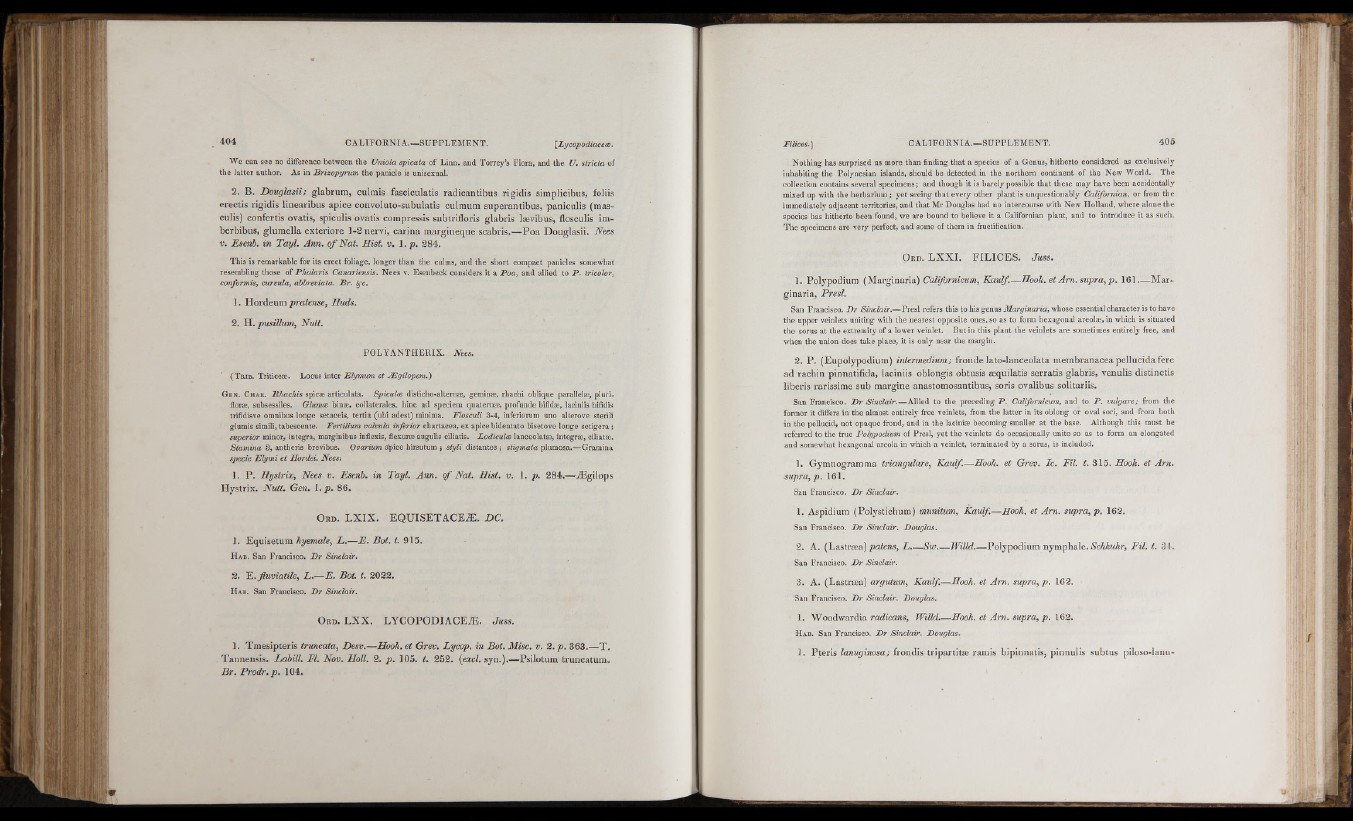
We can see no difference between the Uniola spicata of Linn, and Torrey’s Flora, and the U. stricta of
the latter author. As in Brizopyrum tbe panicle is unisexual.
2. B. Douglasii; g labrum, culmis fasciculatis radic antibus rig id is simplicibus, foliis
erectis rigidis linearibus apice convoluto-subulatis culmum superantibus, paniculis (mas-
culis) confertis ovatis, spiculis ovatis compressis subtrifloris glabris lævibus, flosculis imberbibus,
g lumella exte riore 1-2 nervi, ca rin a margineque scabris.— P o a Douglasii. Nees
V. Esenb. in Tay l. Ann. o f N a t. H i s t v. l . p . 284.
This is remarkable for its erect foliage, longer than the culms, and the short compact panicles somewhat
resembling those of Phalaris Canariensis. Nees v. Esenbeck considers it a Poa, and allied to P . tricolor,
conformis, curvula, abbreviata. B r . ^ c .
1. Ho rdeum pratense, Huds.
2. H. I, Nutt.
PO LY A N TH E R IX . Nees.
( T r ib . Triticeæ. Locus inter Elymum et Ægilopem.')
G e n . C h a r , lihachis spicæ articulata. Spiculæ disticho-alternæ, geminæ, rhachi oblique parallelæ, pluri-
floræ, subsessiles. Glumæ binæ, collatérales, hinc ad speciem quaternæ, profunde bifidæ, laciniis bifidis
trifidisve omnibus longe setaceis, tertia (ubi adest) minima. Flosculi 3-4, inferiorum uno alterove sterili
glumis simili, tabescente. Ferlilium valvula inferior chartacea, ex apice bidentato bisetove longe setigera ;
superior minor, integra, marginibus inflexis, flexuræ augulis ciliatis. Lodiculæ lanceolatæ, integræ, ciliatæ.
Stamina 3, antheris brevibus. Oaarîwm ápice hirsutum ; styli distantes; srfÿmato plumosa.—Gramina
specie E lym i et Hordei. Neest
1. P . Hy strix , Nees v. Esenb. in Ta yl. A n n . o f Nat. H is t. v. I. p . 2 84.— Ægilops
H y s trix . N u t t Gen. 1. p . 86.
O r d . L X IX . E Q U IS E T A C E Æ . DC .
1. Equisetum hyemale, L .—E . Bot. t 915.
H a b . San Francisco. D r Sinclair.
2. E . flu via tile , L .— E . B o t t. 2022.
H a b . San Francisco. D r Sinclair.
O r d . L X X . L Y C O P O D IA C EÆ . Juss.
1. Tmesipteris truncata, Desv.—Hook, et Grev. Lycop. in Bot. Misc. v. 2. p . 3 6 3 .—T .
Tannensis. Lahill. Fl. Nov. Holl. 2. p . 105. t. 252. {excl. syn.).—Psilotum truncatum.
B r . Prodr. p . 104.
Nothing has surprised us more than finding that a species of a Genus, hitherto considered as exclusively
inhabiting the Polynesian islands, should be detected in the northern continent of the New World. The
collection contains several specimens; and though it is barely possible that these may have been accidentally
mixed up with the herbarium j yet seeing that every other plant is unquestionably Californian, or from the
immediately adjacent territories, and that Mr Douglas had no intercourse with New Holland, where alone the
species has hitherto been found, we are bound to believe it a Californian plant, and to introduce it as such.
The specimens are very perfect, and some of them in fructification.
O r d . L X X I . E IL IC E S . Juss.
1. Polypodium {Marginaría) Californicum, Kaulf.— Hook, et A rn. supra, p . 161— M a rginarla,
Presl.
San Francisco. Dr Sinclair.—Presl refers this to his genus Marginaría, whose essential character is to have
the upper veinlets uniting with the nearest opposite ones, so as to form hexagonal areolæ, in which is situated
the sorus at the extremity of a lower veinlet. Butin this plant the veinlets are sometimes entirely free, and
when the union does take place, it is only near the margin.
2. P . (Eupolypodium) intermedium; fronde lato-lanceolata membranacea pellucida fere
ad rachin pinnatifida, laciniis oblongis obtusis æquilatis serratis glabris, venulis distinctis
liberis rarissime sub margine anastomosantibus, soris ovalibus solitariis.
San Francisco. D r Sinclair.—Allied to the preceding P . Californicum, and to P . vulgare; from the
former it differs in the almost entirely free veinlets, from the latter in its oblong or oval sori, and from both
in the pellucid, not opaque frond, and in the laciniæ becoming smaller at the base. Although this must be
referred to the true Polypodium of Presl, yet the veinlets do occasionally unite so as to form an elongated
and somewhat hexagonal areola in which a veinlet, terminated by a sorus, is included.
]. Gymnograrama triangulare, Kaulf.—Hook, et Grev. Ic. Fil. t. 315. Hook, et A rn.
supra, p . 161.
San Francisco. D r Sinclair.
1. Aspidium (Polystichum) munitum, Kaulf.—Hook, et A rn. supra, p . 162.
San Francisco. D r Sinclair. Douglas.
2. A. (Lastræa) patens, L — Sw ___Willd.— Polypodium nymphale. Schkuhr, F il. t. 34.
San Francisco. D r Sinclair.
3. A. (Lastræa) argutum, Kaulf.—Hook, et A rn . supra, p . 162.
San Francisco. D r Sinclair. Douglas,
1. Woodwardia rarffcans, Willd.—Hook, et Arn. supra, p . \6 2 .
H a b . San Francisco. D r Sinclair. Douglas.
L P t e r i s f r o n d i s trip a rtitæ ramis bipinnatis, pinnulis subtus piloso*lanu